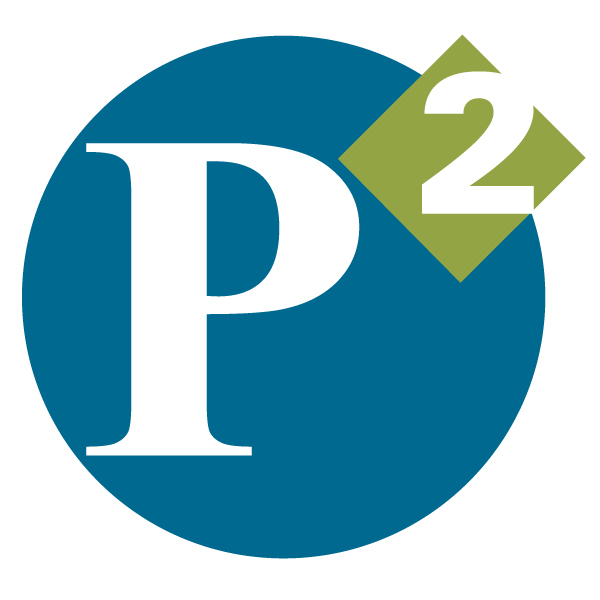NATIONAL POLLUTIOn pREVENTION rOUNDTABLE |
2006 mvp2 awards

The 2006 recipients of the National Pollution Prevention Roundtable’s (NPPR) Most Valuable Pollution Prevention (MVP2) awards reduced pollution by 8 million pounds, conserved more than 500 million kWh of electricity, and reduced water use by over 200 million gallons while cutting costs by over $6 million.
P2 Project/Program Award: EnviroStars Cooperative (Washington, Statewide)
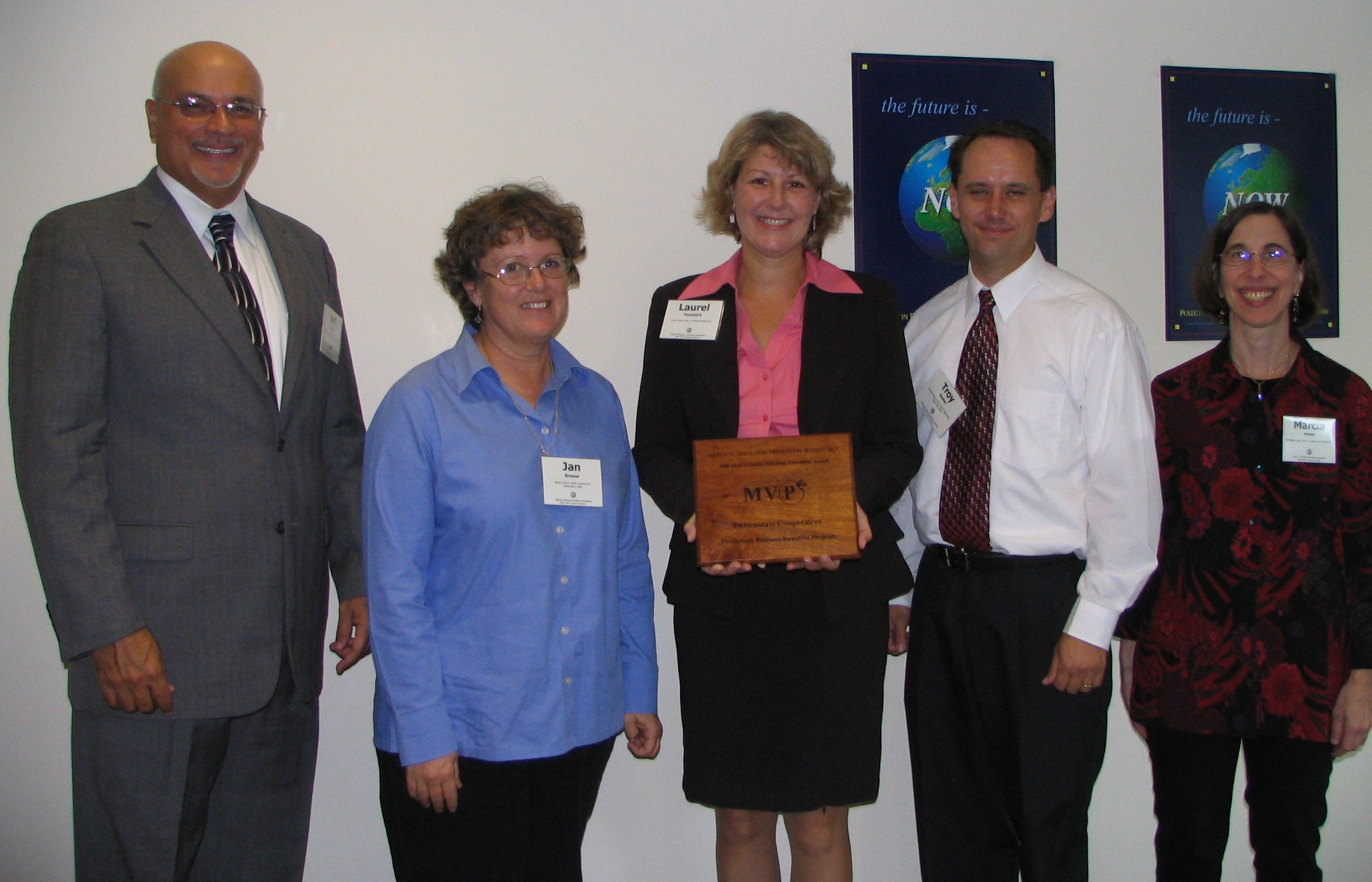
The EnviroStars Business Incentive Program, which began in King County (Seattle-area), Washington in 1995, certifies companies’ efforts to prevent pollution and reduce hazardous waste and helps the public to identify environmentally responsible businesses in their communities. The program has since been adopted by five Local Hazardous Waste Management Programs across Washington State: Jefferson, King, Kitsap, Pierce, and Whatcom counties. This group of county programs has formed an implementation organization called the EnviroStars Cooperative. County-based program representatives work with businesses to evaluate and improve hazardous waste management practices, as well as to provide recommendations and resources for addressing a comprehensive list of sustainable practices, in order to minimize environmental impact and which lead to a range of economic and other business benefits. By the end of 2005:
- 573 businesses had enrolled
- Automotive repair shops had reduced an estimated 448 tons, or 66,934 lbs, of hazardous wastes and have saved over $210,000 annually
- Dry Cleaners reduced an estimated 200 tons, or 42,828 lbs, of hazardous wastes
- Mercury levels measured by the wastewater treatment plants were reduced by 50 percent because of new dentists’ practices
P2 Project/Program Award: Maryland Environmental Management System (EMS) Implementation Assistance Program (Maryland, Statewide)
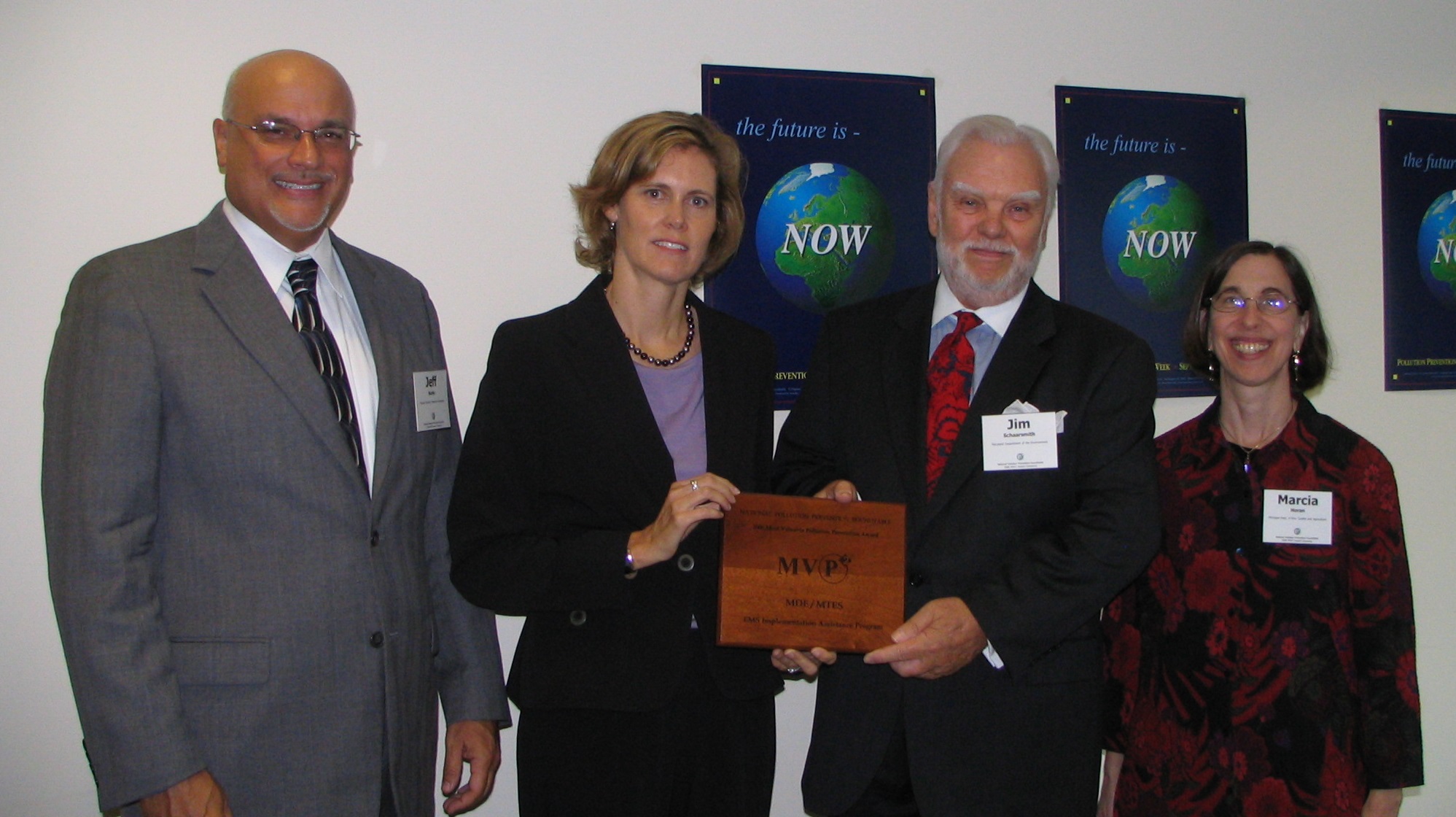 The Maryland Department of Environment - Maryland Technology Extension Service (MDE/MTES), Environmental Management System (EMS) Implementation Assistance Program was created in 2001 and has worked with 28 companies to date. This free program works with groups of three to five businesses at a time. To participate, each business must provide a letter of commitment signed by the highest level of management at their facility, assign an EMS team, send at least two representatives to the four group workshops, and commit to completing implementation of an EMS within the intensive six-month project period. The MDE/MTES program provides workshops and meetings to facilitate completing the EMS along with pollution prevention technical assistance. At the conclusion of the program, each facility is encouraged to take advantage of a free, informal EMS audit offered by the program. All 8 facilities that chose to register to the ISO 14001 standard were successful on their first registration audit. One 18-business project had over 7.5 million pounds of waste reduction in the first year of implementation at a cost savings of $109,440. Other participating companies have successfully reduced energy, fuel, water use and discharge, hazardous waste, solid waste, and more at their facilities.
The Maryland Department of Environment - Maryland Technology Extension Service (MDE/MTES), Environmental Management System (EMS) Implementation Assistance Program was created in 2001 and has worked with 28 companies to date. This free program works with groups of three to five businesses at a time. To participate, each business must provide a letter of commitment signed by the highest level of management at their facility, assign an EMS team, send at least two representatives to the four group workshops, and commit to completing implementation of an EMS within the intensive six-month project period. The MDE/MTES program provides workshops and meetings to facilitate completing the EMS along with pollution prevention technical assistance. At the conclusion of the program, each facility is encouraged to take advantage of a free, informal EMS audit offered by the program. All 8 facilities that chose to register to the ISO 14001 standard were successful on their first registration audit. One 18-business project had over 7.5 million pounds of waste reduction in the first year of implementation at a cost savings of $109,440. Other participating companies have successfully reduced energy, fuel, water use and discharge, hazardous waste, solid waste, and more at their facilities.
P2 Project/Program Award: Michigan Turfgrass Environmental Stewardship Program (Michigan, Statewide)
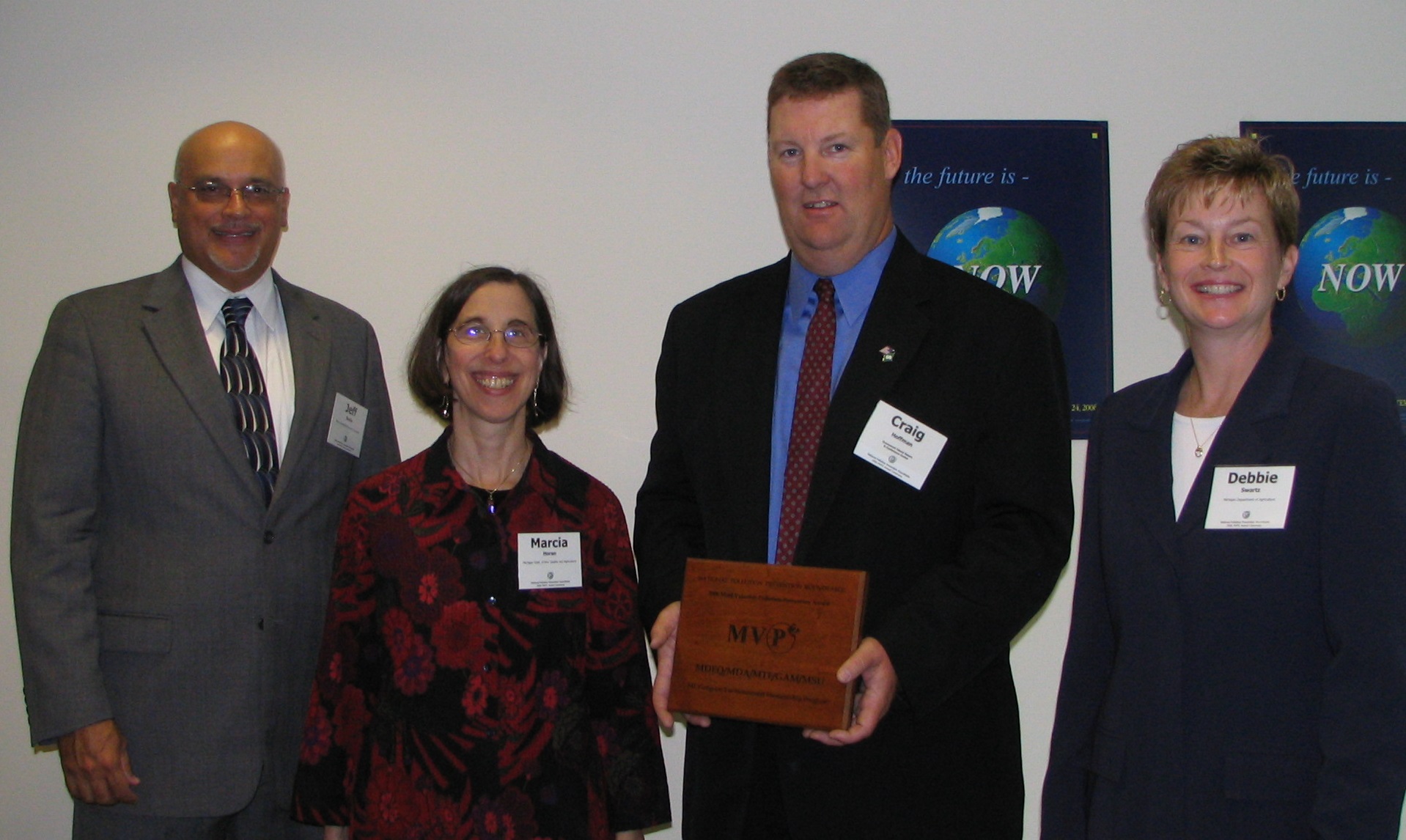 Michigan turfgrass is a $1.86 billion industry, employing 30,000 people and encompassing 1.9 million acres of land. The Michigan Turfgrass Environmental Stewardship Program (MTESP) is a voluntary proactive initiative designed to prevent pollution and increase compliance with environmental laws on golf properties by offering on-site visits and workshops promoting pollution prevention best practices such as buffer strips, closed loop wash water systems, and environmentally preferable purchasing. The program represents a unique partnership between: Michigan Department of Environmental Quality, Michigan Department of Agriculture, Michigan Turfgrass Foundation, Michigan State University, Michigan Golf Course Owners Association, Golf Association of Michigan, and the Michigan Golf Course Superintendents Association. The MTESP currently has 234 golf courses voluntarily participating in the program and has certified 63. https://www.mtesp.org/
Michigan turfgrass is a $1.86 billion industry, employing 30,000 people and encompassing 1.9 million acres of land. The Michigan Turfgrass Environmental Stewardship Program (MTESP) is a voluntary proactive initiative designed to prevent pollution and increase compliance with environmental laws on golf properties by offering on-site visits and workshops promoting pollution prevention best practices such as buffer strips, closed loop wash water systems, and environmentally preferable purchasing. The program represents a unique partnership between: Michigan Department of Environmental Quality, Michigan Department of Agriculture, Michigan Turfgrass Foundation, Michigan State University, Michigan Golf Course Owners Association, Golf Association of Michigan, and the Michigan Golf Course Superintendents Association. The MTESP currently has 234 golf courses voluntarily participating in the program and has certified 63. https://www.mtesp.org/
P2 Project/Program Award: National Center for Remanufacturing and Resource Recovery (Rochester, NY)
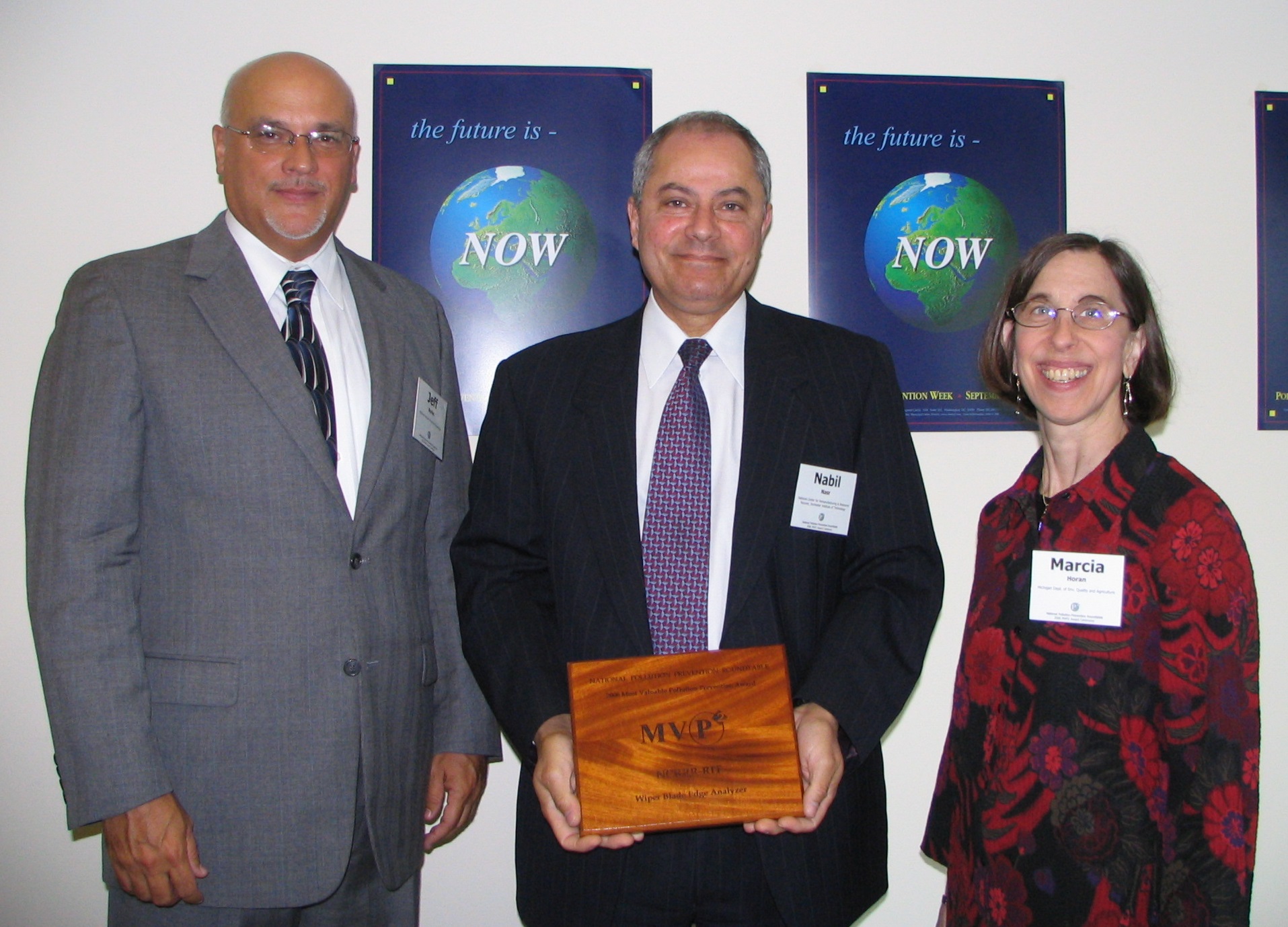 The National Center for Remanufacturing and Resource Recovery (NC3R) at Rochester Institute of Technology (RIT) has been providing technical assistance and applied research and development to companies, industries, and government agencies interested in remanufacturing and resource recovery since 1992. NC3R's Wiper Blade Edge Analyzer project has recently created and implemented a unique and innovative process for recovering a component used in copiers and printers around the world, thereby conserving natural resources and reducing solid waste transferred to landfills. The result of the Wiper Blade Edge Analyzer project is a new technology and process for reclaiming used wiper blades from toner cartridges during the remanufacturing process. Three hundred tons of metal and urethane have been diverted from landfills.
The National Center for Remanufacturing and Resource Recovery (NC3R) at Rochester Institute of Technology (RIT) has been providing technical assistance and applied research and development to companies, industries, and government agencies interested in remanufacturing and resource recovery since 1992. NC3R's Wiper Blade Edge Analyzer project has recently created and implemented a unique and innovative process for recovering a component used in copiers and printers around the world, thereby conserving natural resources and reducing solid waste transferred to landfills. The result of the Wiper Blade Edge Analyzer project is a new technology and process for reclaiming used wiper blades from toner cartridges during the remanufacturing process. Three hundred tons of metal and urethane have been diverted from landfills.
P2 Project/Program Award: PennTAP-ETAC Partnership (Western Pennsylvania)
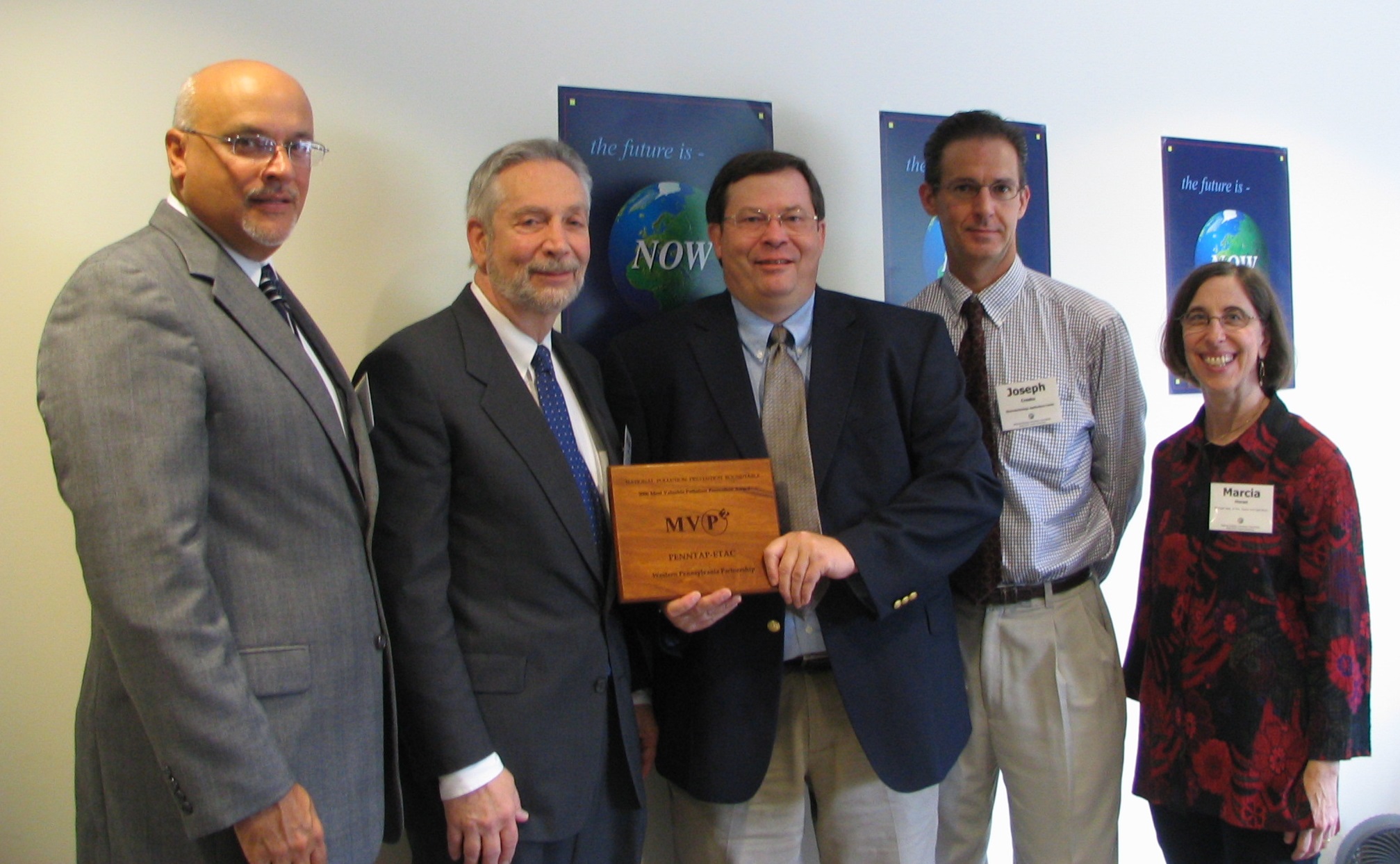 The PennTAP-ETAC Partnership provides outreach and technical assistance to companies in western Pennsylvania regarding pollution prevention and energy efficient opportunities and practices. The Pennsylvania Technical Assistance Program (PennTAP) helps Pennsylvania businesses improve their competitiveness by providing free technical assistance and information to help resolve specific technical questions or needs. The Electrotechnology Application Center at Northampton Community College (ETAC) is a not-for-profit applied research and technical assistance center specializing in applying infrared, ultraviolet, microwave, radio frequency and other types of energy to improve heating, drying, coating, and curing processes used in manufacturing facilities. An important component of these technologies is their ability to improve product quality, increase productivity, improve energy efficiency, reduce costs, and reduce the environmental impact of many industrial processes. This partnership has helped Pennsylvania businesses:
The PennTAP-ETAC Partnership provides outreach and technical assistance to companies in western Pennsylvania regarding pollution prevention and energy efficient opportunities and practices. The Pennsylvania Technical Assistance Program (PennTAP) helps Pennsylvania businesses improve their competitiveness by providing free technical assistance and information to help resolve specific technical questions or needs. The Electrotechnology Application Center at Northampton Community College (ETAC) is a not-for-profit applied research and technical assistance center specializing in applying infrared, ultraviolet, microwave, radio frequency and other types of energy to improve heating, drying, coating, and curing processes used in manufacturing facilities. An important component of these technologies is their ability to improve product quality, increase productivity, improve energy efficiency, reduce costs, and reduce the environmental impact of many industrial processes. This partnership has helped Pennsylvania businesses:
- Reduce 6,000,000 kWh/yr in electric energy,
- Reduce 100,000 mcf/yr in natural gas,
- Reduce 20,000,000 lbs/yr in air emissions,
- Reduce 1,800,000 lbs/yr in solid wastes,
- Reduce 73,000,000 gal/yr in water use and wastewater,
- Save $2,600,000 per year.
P2 Project/Program Award: Steelcase, Inc. (Grand Rapids, MI)
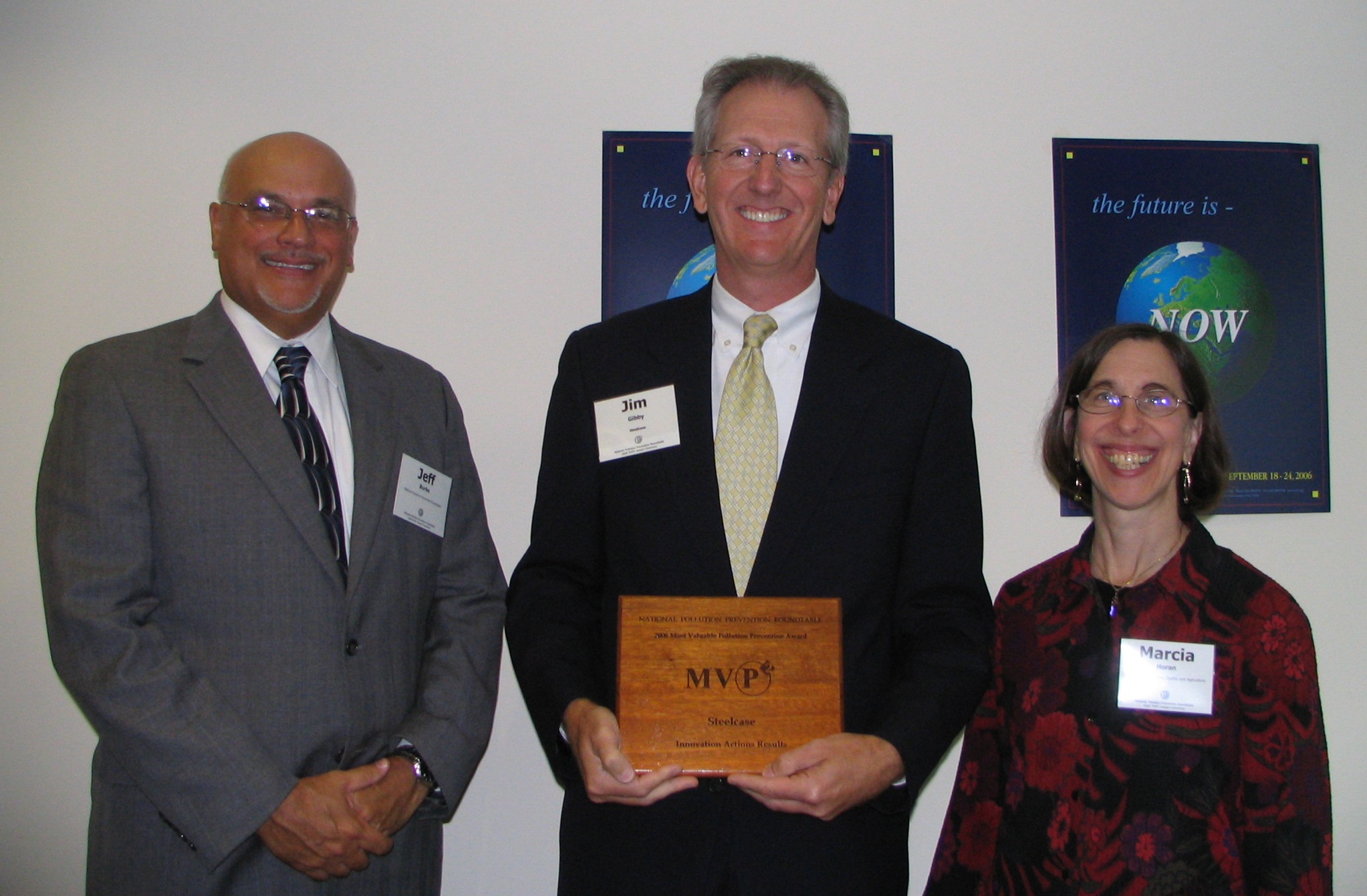 2006 Environmental Report: “Nearly 100 years ago we made a promise – that we would act as stewards of the environment. Since then, we’ve been dedicated to serving our customers in a way that never becomes a disservice to our planet. We believe that, big or small, every action that safeguards and restores the environment is significant. By inspiring lasting, meaningful action, we can all benefit from lasting, meaningful results.” –James P. Hackett, Steelcase President and CEO.
2006 Environmental Report: “Nearly 100 years ago we made a promise – that we would act as stewards of the environment. Since then, we’ve been dedicated to serving our customers in a way that never becomes a disservice to our planet. We believe that, big or small, every action that safeguards and restores the environment is significant. By inspiring lasting, meaningful action, we can all benefit from lasting, meaningful results.” –James P. Hackett, Steelcase President and CEO.
- Protected 360,000 acres across Michigan
- Reduced GHG emissions by 41%, or about 155,000 metric tons since 2001
- Reduced VOC emissions by 95%, or about 1,045 tons
- Reduced water consumption by 54%
- Decreased energy consumed by 45%, or about 560,000,000 kilowatt-hours
P2 Project/Program Award: Tinker Air Force Base, Environmental Management Division (CEV) (Oklahoma County, OK)
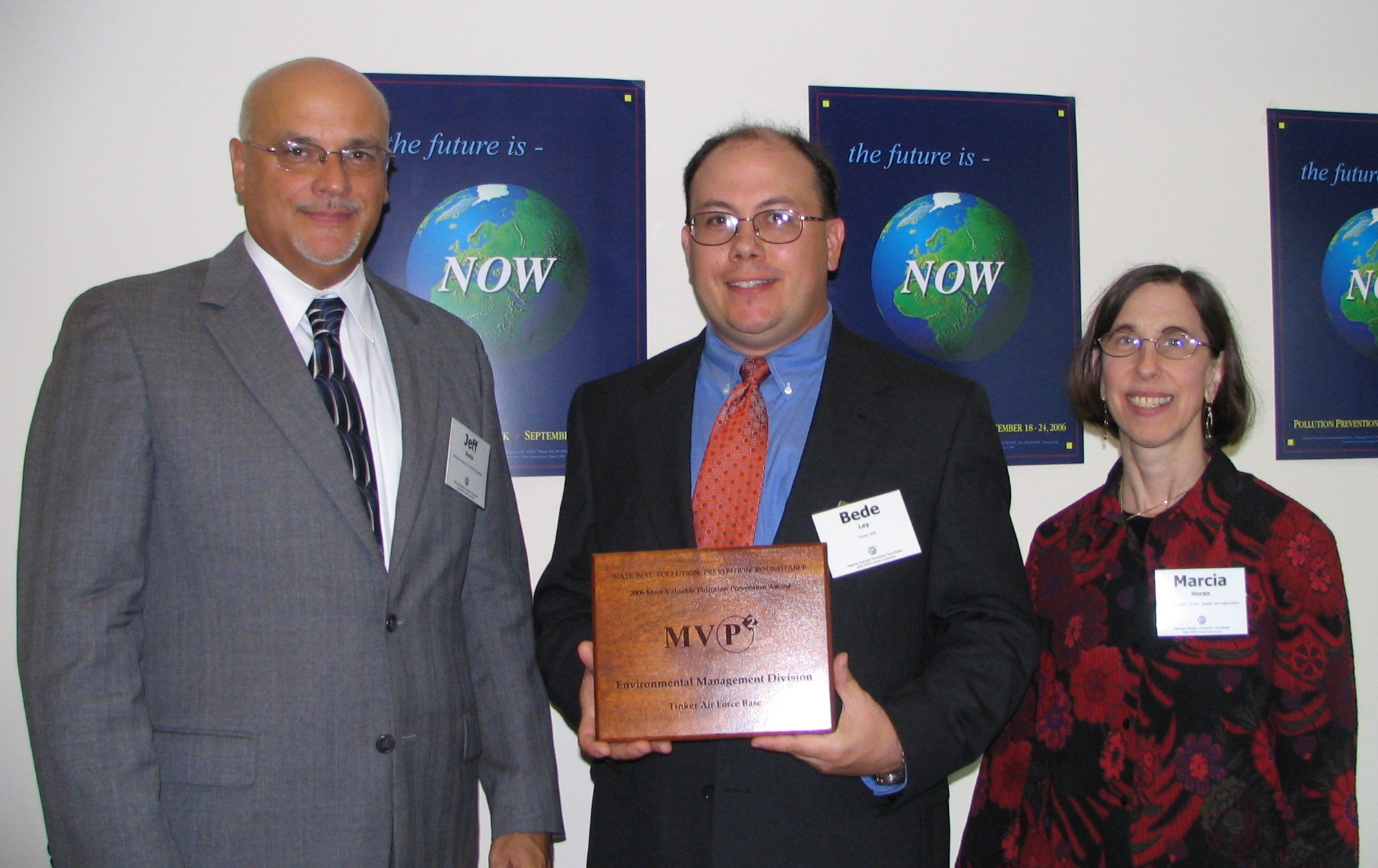 Over the past two years, CEV has remained focused on its mission to serve as the TAFB focal point for all environmental issues by developing and implementing policies, programs, and procedures that ensure base-wide compliance with environmental requirements while fully supporting base missions. CEV has demonstrated continued commitment to its mission by implementation of its strategic vision:
Over the past two years, CEV has remained focused on its mission to serve as the TAFB focal point for all environmental issues by developing and implementing policies, programs, and procedures that ensure base-wide compliance with environmental requirements while fully supporting base missions. CEV has demonstrated continued commitment to its mission by implementation of its strategic vision:
- Reach out to neighbors;
- Seek new ways to fulfill TAFB’s environmental mission;
- Apply cutting-edge technologies to processes;
- Provide state-of-the-art training.
As a result, CEV:
- Reduced chrome by 28,000 gallons and saved $120,000 annually
- Reduced VOC's by 16 tons
- Reduced hazardous waste volume by 3,450 tons
- Reducted energy consumption by 25,000 MBtu/yr
- Reduced coolant disposal by 200 tons
- Diverted 42 tons of metal sludge and 30 tons of compost.
P2 Project/Program Award: Yellowstone National Park and US EPA Region 8 - Greening of Yellowstone Partnership (Mammoth, WY)
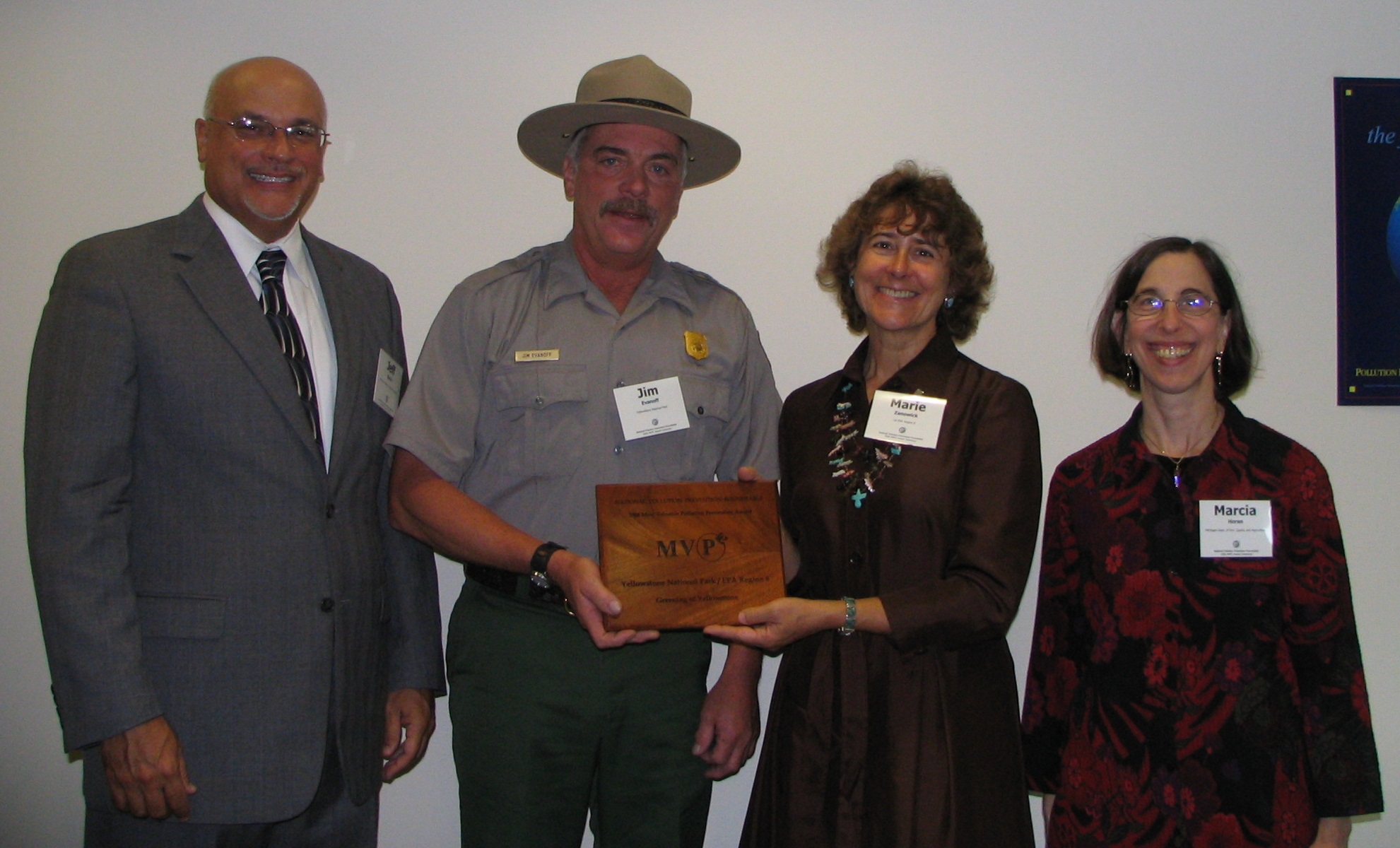 In 1997, when Yellowstone National Park celebrated its 125th anniversary as the world’s first national park, park staff began thinking forward to the next 125 years and the sustainable efforts that would ensure the preservation and protection of Yellowstone. As a result, the concept of the "Greening of Yellowstone" was created. The main goal of this effort is to implement changes in how the park does business that result in reducing and/or eliminating pollution while providing an example to our visitors and to other land management agencies. To support these efforts, the park entered into a formal partnership with EPA Region 8’s Pollution Prevention Team and implemented an Environmental Management System (EMS) focused on pollution prevention and sustainability. The Greening of Yellowstone is an innovative project, as it has effectively tackled problems with implementing sustainability practices in a remote area. In 2005 the project:
In 1997, when Yellowstone National Park celebrated its 125th anniversary as the world’s first national park, park staff began thinking forward to the next 125 years and the sustainable efforts that would ensure the preservation and protection of Yellowstone. As a result, the concept of the "Greening of Yellowstone" was created. The main goal of this effort is to implement changes in how the park does business that result in reducing and/or eliminating pollution while providing an example to our visitors and to other land management agencies. To support these efforts, the park entered into a formal partnership with EPA Region 8’s Pollution Prevention Team and implemented an Environmental Management System (EMS) focused on pollution prevention and sustainability. The Greening of Yellowstone is an innovative project, as it has effectively tackled problems with implementing sustainability practices in a remote area. In 2005 the project:
- Achieved 65 percent diversion rate of solid waste from going to the landfill
- Replaced 500 feet of boardwalk with recycled plastic materials
- Produced more than 1,400 tons from the park’s solid waste stream
- Reduced carbon dioxide emissions into the atmosphere by 522 metric tons by using alternative fuels
- Installed a solar electric array at the Lamar Buffalo Ranch, located within the park, that provides more than 90 percent of the complex's energy needs, annually.
P2 Project/Program Award: Zinc Thermal Diffusion Coating - US EPA ORD Cincinnati and UnStain North America, LLC (Johannesburg, South Africa)
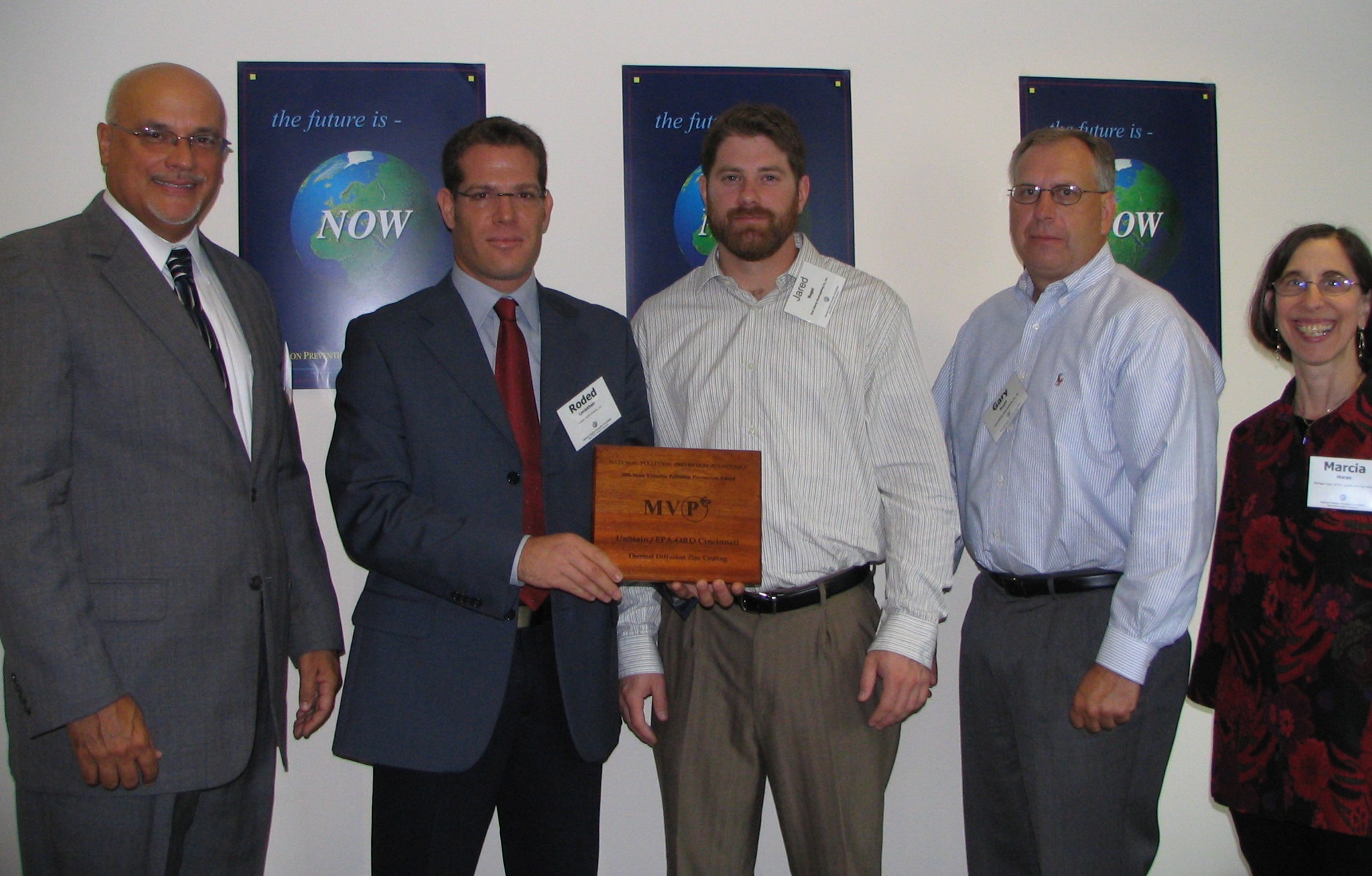 Zinc thermal diffusion is a newer zinc coating process that forms a zinc alloy with the substrate. The process is designed to coat fasteners as well as small and medium-sized items, including threaded items, made of steel and cast iron with a required thickness of coating above 15 micron. The technology (1) adheres to lightly rusted (oxidized) parts and/or parts with light oils without pretreatment, (2) provides two to four times the corrosion protection as compared to competitive processes such as hot dip galvanizing and electro-galvanizing, and (3) is a near zero discharge process. The US EPA evaluated the pollution discharge from the manufacturing process by inspecting and obtaining parts from a plant in Johannesburg, South Africa, as well as from UnStain North America, LLC, and other parts that are zinc coated with other methods. EPA concluded that the original part does not have to be replaced or reworked as frequently which has pollution and cost savings. Ninety percent of the parts can skip the pre-treatment step and the associated pollution. There are no air stack emissions or water discharges and all sludge is recycled back into virgin product. The corrosion resistance was evaluated by EPA and was superior to traditional zinc coatings.
Zinc thermal diffusion is a newer zinc coating process that forms a zinc alloy with the substrate. The process is designed to coat fasteners as well as small and medium-sized items, including threaded items, made of steel and cast iron with a required thickness of coating above 15 micron. The technology (1) adheres to lightly rusted (oxidized) parts and/or parts with light oils without pretreatment, (2) provides two to four times the corrosion protection as compared to competitive processes such as hot dip galvanizing and electro-galvanizing, and (3) is a near zero discharge process. The US EPA evaluated the pollution discharge from the manufacturing process by inspecting and obtaining parts from a plant in Johannesburg, South Africa, as well as from UnStain North America, LLC, and other parts that are zinc coated with other methods. EPA concluded that the original part does not have to be replaced or reworked as frequently which has pollution and cost savings. Ninety percent of the parts can skip the pre-treatment step and the associated pollution. There are no air stack emissions or water discharges and all sludge is recycled back into virgin product. The corrosion resistance was evaluated by EPA and was superior to traditional zinc coatings.
P2 Publication Award: Dan Ahern and John Calcagni (Atlanta, GA and Raleigh, NC)
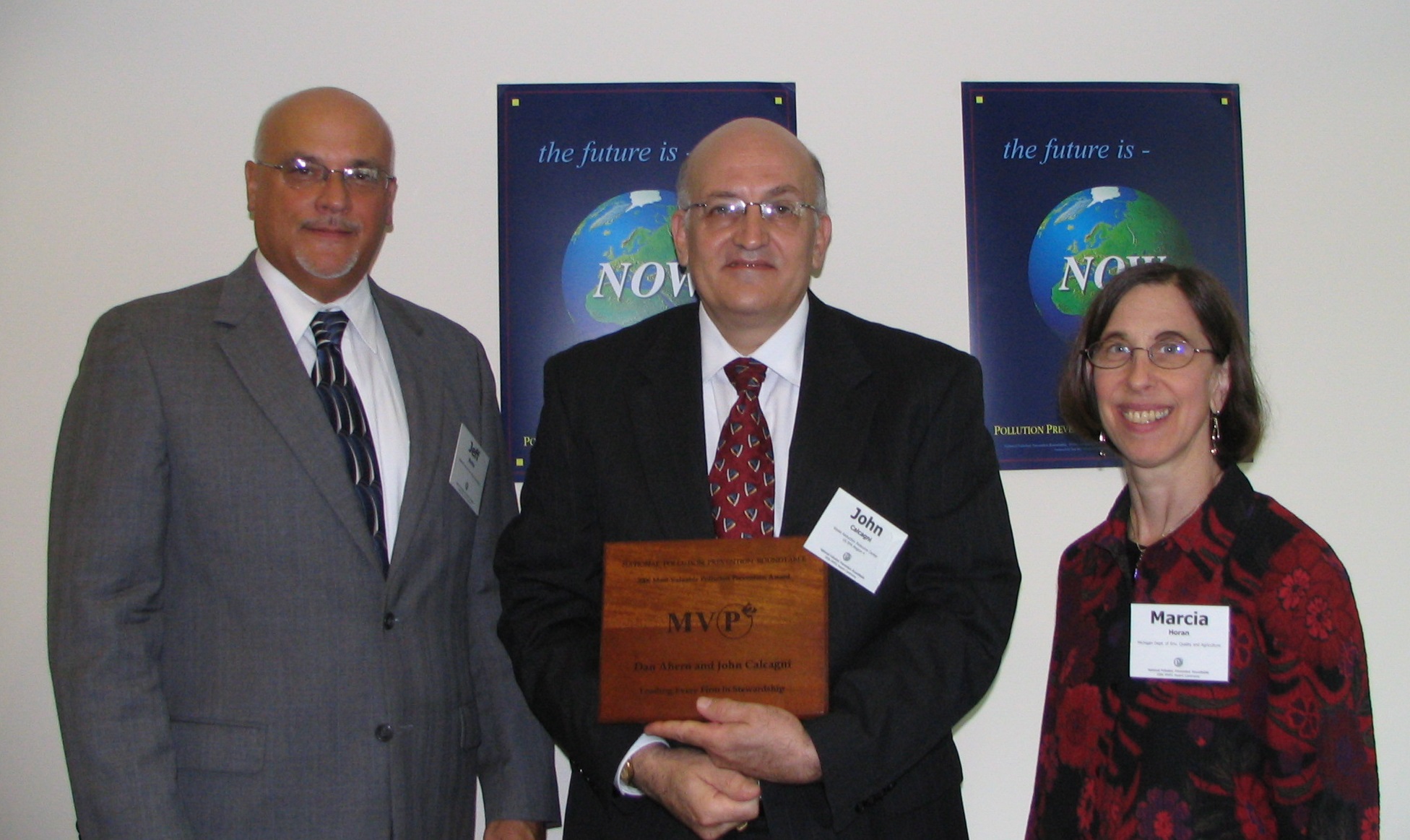 Dan Ahern with US EPA Region 4 and John Calcagni with the Waste Reduction Resource Center won for their publication, "Implementing the Pollution Prevention Act of 1990 - Leading Every Firm to Stewardship". This work presents a methodical, integrated, comprehensive approach to applying many of the techniques and tools that have been shown to be effective in promoting pollution prevention. It recognizes that members of the business community have different motivations and presents a methodical approach to identify which measures are most likely to be effective with each type of firms and when to best implement the measure to maximize impact. John and Dan crafted a well written document which presents the P2 dilemma in a different way and presented this work at the 2006 National Environmental Partnership Summit. https://p2infohouse.org/ref/22/21409.pdf
Dan Ahern with US EPA Region 4 and John Calcagni with the Waste Reduction Resource Center won for their publication, "Implementing the Pollution Prevention Act of 1990 - Leading Every Firm to Stewardship". This work presents a methodical, integrated, comprehensive approach to applying many of the techniques and tools that have been shown to be effective in promoting pollution prevention. It recognizes that members of the business community have different motivations and presents a methodical approach to identify which measures are most likely to be effective with each type of firms and when to best implement the measure to maximize impact. John and Dan crafted a well written document which presents the P2 dilemma in a different way and presented this work at the 2006 National Environmental Partnership Summit. https://p2infohouse.org/ref/22/21409.pdf
P2 Publication Award: Paul Orum
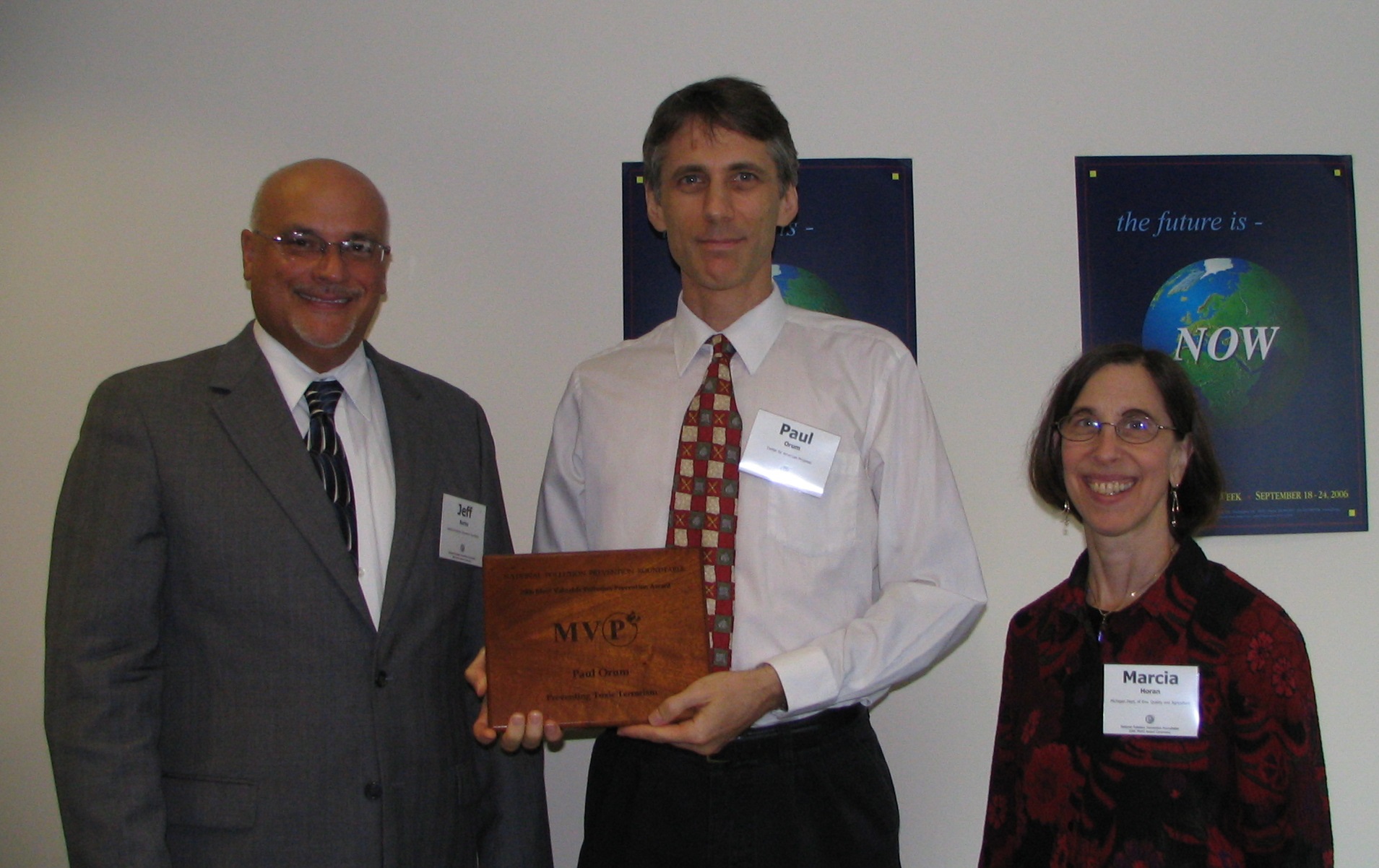 Paul Orum designed the survey for and authored the report, "Preventing Toxic Terrorism: How Some Chemical Facilities are Removing Danger to American Communities". The Center for American Progress, with assistance from the National Association of State PIRGs and National Environmental Trust, conducted a survey of facilities which no longer report using extremely hazardous substances under the federal Risk Management Planning program to identify such facilities and spotlight successful practices that have removed unnecessary chemical dangers. This survey found that facilities across the country, representing a range of industries, have switched to safer alternatives from a variety of hazardous chemicals, producing dramatic security and safety benefits at a reasonable cost. This report makes the connection between pollution prevention and homeland security. The report also shows how simple substitutions can decrease the risks to local populations, suggests transferability to a number of industries, and showcases a variety of examples showing feasibility for others to do the same. https://cdn.americanprogress.org/wp-content/uploads/2006/04/chem_survey.pdf
Paul Orum designed the survey for and authored the report, "Preventing Toxic Terrorism: How Some Chemical Facilities are Removing Danger to American Communities". The Center for American Progress, with assistance from the National Association of State PIRGs and National Environmental Trust, conducted a survey of facilities which no longer report using extremely hazardous substances under the federal Risk Management Planning program to identify such facilities and spotlight successful practices that have removed unnecessary chemical dangers. This survey found that facilities across the country, representing a range of industries, have switched to safer alternatives from a variety of hazardous chemicals, producing dramatic security and safety benefits at a reasonable cost. This report makes the connection between pollution prevention and homeland security. The report also shows how simple substitutions can decrease the risks to local populations, suggests transferability to a number of industries, and showcases a variety of examples showing feasibility for others to do the same. https://cdn.americanprogress.org/wp-content/uploads/2006/04/chem_survey.pdfP2 Champion Award: Robert Pojasek

Currently Principal Consultant at SAI Global, Robert (Bob) Pojasek is recognized for his willingness to speak out on behalf of pollution prevention, the depth to which he uses his technical expertise to implement pollution prevention, and his ability to communicate his knowledge and tools through writing articles or conducting training. Bob is an internationally recognized process improvement specialist. He was a pioneer in the area of pollution prevention and is the lead author on the US Environmental Publication, "An Organizational Guide to Pollution Prevention." He worked for the Government of Mexico to provide an independent evaluation of their Voluntary Environmental Audit Program. One of the accomplishments he is most proud of is the development of the New Mexico Green Zia program which is a voluntary program that recognizes, assists, and supports businesses and organizations that strive for environmental excellence. Bob has served on the Science Advisory Boards of the US Environmental Protection Agency and the US Air Force. For seven years, he served as a judge for the national environmental awards program for the American Forest and Paper Association.
P2 Volunteer of the Year: Robert Kerr
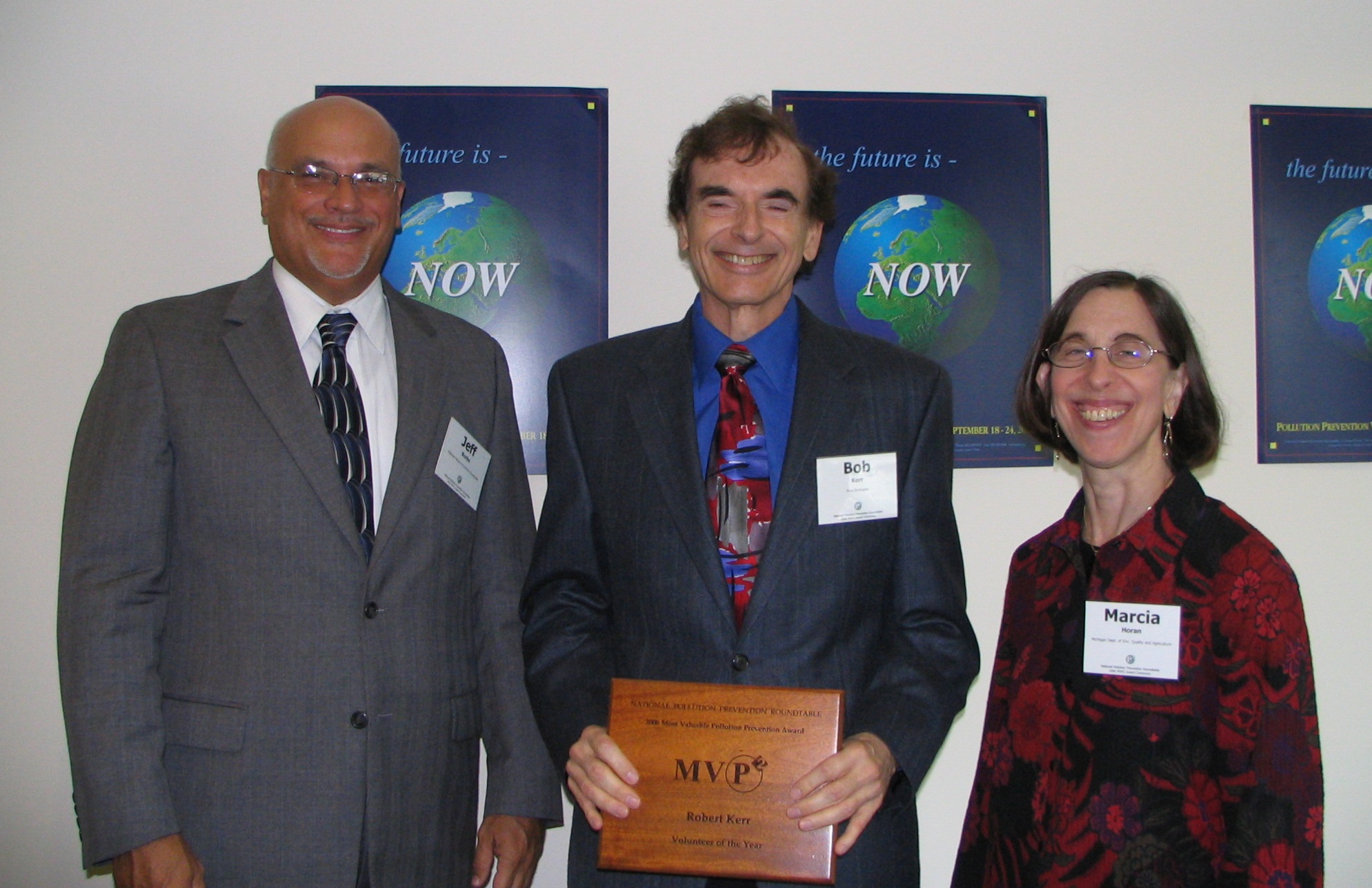
Robert (Bob) Kerr is Co-Founder and Principal of Pure Strategies. Bob works with numerous state programs on integrating pollution prevention into regulatory and non-regulatory agency programs. He has also worked on the development of EPA regulatory-incentive programs, ranging from the Agency's original emissions trading policy to the current Performance Track Program. He is the Co-Chair of the Policy and Integration Workgroup.
